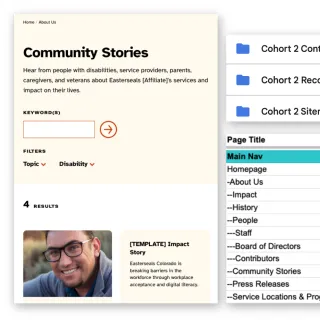

7 Essential Tools for Managing a Massive Affiliate Migration
Easterseals and their network of affiliates provide essential services to millions of children and adults with disabilities, older adults, veterans, and their families, so all can lead full, independent lives. When we began collaborating with Easterseals national, our priorities were to:
- develop a new experience, content, and technical strategy
- build a new platform-as-a-service (PaaS)
- gradually migrate the 44 affiliates from the legacy to the new PaaS.
Why migrate gradually? We humans prefer to stick with what we know. It's just easier, especially when we have multiple competing pressures for our time and attention. A gradual rollout allows time for us to talk through what the change is, why it's coming, and how to pace adoption.
Our (Foiled) Plan
In October 2024, after months of research, planning, building, testing, and refining, we were counting down the days to the new year, and the launch of Eastserseals’ new easy-to-manage, easy-to-understand website and affiliate platform.
We were going to spend the next 18 months onboarding affiliates in small groups. But then we learned that Blackbaud decided to deprecate their CMS much earlier. We had to condense our timeline drastically: just 7 months for affiliates from Joliet to Juneau to onboard and build out their new websites.

Migration Priorities
We gave ourselves a few moments for expressing our thoughts and feelings about the implosion of our carefully crafted migration plan. And then, we turned to the challenges a compressed timeline introduced:
- Strategic continuity: The Easterseals PaaS was founded on a totally new user experience strategy and information architecture. How could we get stakeholder buy-in to such fundamental changes in a very short time?
- Capacity building: Many Easterseals affiliates could assign just one or two staff to the migration project. How could we make the learning curve manageable for staff with many other hats to wear and projects to juggle?
- Communications clarity: Instead of migrating a few affiliates at a time, we needed to handle 44 at once. This meant getting general updates and providing affiliate-specific support to more than 100 program managers and organization leaders. How would we provide timely support without overwhelming our teams?
7 Essential Tools for Enterprise Migration Management
The tools below were critical to maintaining the experience strategy, teaching everyone how to migrate their content and manage their websites, and staying on schedule and on budget.

1. A starter website starter
Affiliates didn’t have to start from scratch. To save affiliates time and get the experience strategy in place, we developed a pre-populated website. Content included:
- A homepage with affiliate-specific content. This first visual experience of the website strategy helps build excitement and a sense of the new possibilities.
- Launch-essential pages with template text. Overwhelmed affiliates can update the copy and images on just these pages and have a website that supports primary conversion goals. Placeholder page titles and body text support the continuation of the content strategy.
2. A migration toolkit
Affiliates are the experts in their content needed to get internal approval and make page-level content decisions. So we supported them by preparing a personalized toolkit with:
- A sitemap template of must-have and nice-to-have pages, ready for affiliates to customize for their audiences and content
- An adapted taxonomy to reflect local needs
- An inventory of all content in their current CMS
- A launch communications plan with recommended activities grouped by criticality and deadline.
3. A knowledge base
A knowledge base centralizes documentation, so participants only have to check one place for help. We included folders for:
- Background on the process for designing the website and strategic goals
- Workshop decks and recordings
- FAQs meeting recordings and documentation
We used Google Drive to start because of its familiarity and ease of access. We’re now vetting solutions with AI-based chatbots like Notion and Confluence to support ease of use as we implement enhancements and the documentation grows.
4. Affiliate Cohorts
To ensure that we could get to know each affiliate’s team, we took a cue from high school and created four cohorts, each of which met monthly on a different day of the week. Affiliates could sign up for the cohort that worked best with their schedule. Cohort planning included:
- A pilot group that launched with the national team, to help us better anticipate affiliate needs
- A workshop series, with each session focused on a different type of content
- Cascading schedules, so if affiliates had to miss a session, they could join the next and stay on schedule
5. Progress & Pre-launch Dashboards
Knowing that affiliates had many projects to balance, we wanted a way to follow their progress—and keep an eye out for launch risk—without pulling them out of other work. To that end, we created two dashboards:
- A content progress dashboard that showed each affiliate’s percent of drafted and completed sitemap pages
- A pre-launch task dashboard in Monday.com for tracking the status of the 16 steps required for launch for every affiliate. Automations kept task owners up to date on completion status and launch risk level
6. Clear Communications Times & Channels
Distinct communication channels helped us manage time-sensitive questions, and allowed affiliates to benefit from each others’ experiences and expertise. We offered:
- Weekly office hours to get real-time support from our team and the larger group
- Support requests through Freshdesk tickets for questions and help requests between workshop sessions
7. Enhancements Plan
A slower rollout would have let us run a product enhancements cycle in parallel with affiliate migrations. With a compressed timeline, it was all hands on deck to get everyone launched before the deadline. But affiliates know we’ll be ready to collaborate on product improvements as soon as we get to November, because we already have:
- An intake form for post-launch enhancements requests
- A rubric for consistent and transparent request evaluation
Planning for Imperfection

I realize a tidy tools list suggests we had, and you’ll have, a surprise-free migration. As with any human endeavor, that was not to be. We planned our launch timeline and resourcing on the assumption that 10 to 15 percent of affiliates would need extra time and content creation support.
The 3 biggest challenges have been managing scheduling conflicts, staff turnover, and all-hands-on-deck projects like summer camps and fundraisers. A few affiliates have indeed needed to move to later launch dates. But most are right on schedule. (Check out our newest additions, including Easterseals DC MD VA, Iowa, and Southeastern Pennsylvania!)
And with each launch—planned, imperfect, impactful—we’re proud to be part of the Easterseals community dedicated to supporting more than 70 million Americans living with disabilities.

